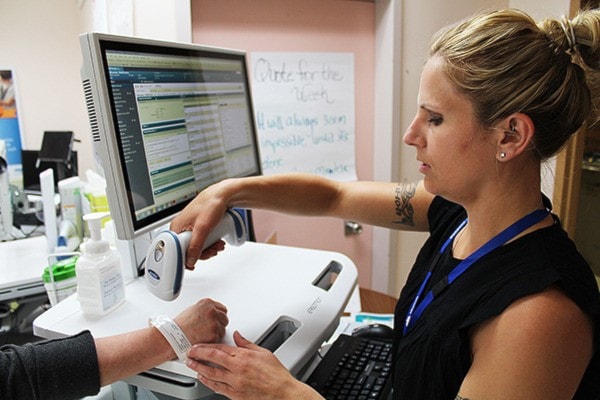Island Health remains firmly committed to iHealth.
But two months into its initial rollout in Nanaimo, the health of Vancouver Island’s groundbreaking $178-million paperless system is proving difficult to diagnose.
On one hand, you’ve got administrators saying more than 400 errors that would have slipped through under previous paper-based methods have already been caught by the new electronic record-keeping system.
On the other, you hear talk of frustrated doctors considering defying their bosses and reverting to the old system in the emergency room of Nanaimo Regional General Hospital in order to speed up diagnosis and treatment.
Ten years in the making, iHealth went live in the Nanaimo area March 19 as the first phase of a multi-step process to see it fully implemented in every facility in the Island Health region by 2018.
For the past eight weeks, each NRGH nurse has been trundling through hospital hallways with a wheeled touch-screen computer console, voice-recognition dictation software and a bar code scanner designed to track and record each patient’s diagnosis, treatment and history at the touch of a button.
Ultimately, the system is aimed at improving patient safety by bringing clarity, consistency and easy access to their records, with built-in safeguards designed to ensure they are getting the right doses of the right treatments at the right times.
But while iHealth appears to be largely delivering on those promises, its implementation has also slowed the work flow enough that some are questioning whether the gains are worth the losses.
While procedures for things like lab and diagnostic orders have reportedly been improved, that hasn't necessarily been the case in some of the more intense areas of the hospital, like the ER and the intensive care unit.
“The overwhelming concern I am hearing is the effect on patient care,” Nanaimo Division of Family Practice Chairwoman Dr. Melissa Oberholster said. “Are there less procedures? Are waiting lists getting longer?”
Oberholster was very cautious not to be seen as passing judgment on the system, adding she has heard both positive and negative reports, but only on an ad hoc basis. She said Nanaimo area doctors are meeting next week to discuss the situation more fully.
“It’s difficult to speak about it because we have only heard anecdotes,” she said. “We have certainly heard the morale has been low. We will get the family doctors together to get a better idea of the impact.
“The other piece is that we haven’t had the doctors and the nurses together; how is it affecting working relationships and our collegiality?”
Rachel Kimler, the B.C. Nurses Union spokeswoman for Nanaimo said the nurses are in a similar place.
“There is not a lot I can say. The union supports and will continue to support electronic records,” Kimler said. “Some of it is growing pains, some of it may be system-related.”
Island Health’s chief information officer Catherine Claiter Larsen acknowledged the process has been painful, but said growing pains were expected as people switch to an entirely new way of doing things.
“It looks like a very normal distribution of the learning curve: some people already running down the other side; a few are not willing to start the climb; most are around the top of the hill,” she said. “It’s still going as expected with a change of this magnitude. It will take a good six months for everyone to return to their levels.”
Claiter Larsen said that while doctors are frustrated about the increased time it takes them to log information into the system, they are overlooking the time saved on the other end of the process. Nurses and pharmacists are no longer struggling to decipher hand-scrawled messages. The iHealth system has drastically reduced the number of follow-up calls and rewritten prescriptions.
“It was easy to scribble. They forget the amount of time it took for pharmacists to track them down.”
Oberholster said the experiences of other jurisdictions — Island Health is the second largest and seventh overall in North America to go completely digital — is reason to be skeptical.
“We will make some gains. If you read most of the information you get, you do not ever recover that productivity back to the baseline.”
Claiter Larsen said there is a payoff.
“We will never achieve perfect comfort, but people will begin to notice it less as time goes by. I’d like to acknowledge the perseverance of our Nanaimo partners,” she said. “The first activation is the hardest one. Patient care will be more safe and of a higher quality.”
Dufferin Place residential care centre in Nanaimo and Oceanside Health Centre in Parksville joined NRGH as the iHealth Guinea pigs. Next up is Campbell River and the Comox Valley, with the aim of getting staff acclimated to the new system before the new hospitals open in those communities in 2017.
At the end of the process iHealth will be in place across the entire Island Health system, not just hospitals.
"What our board has asked of us is to make sure we do it right," Craiter Larsen said. “Other industries are so far ahead of us. This is the future of health care. This is what the next generation uses every day.”
Follow me on Twitter @JohnMcKinleyBP



